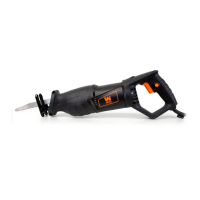5
SPECIFIC RULES FOR RECIPROCATING SAWS
9. Never cut pressurized tanks or any containers containing hazardous or flammable materials.
10. Never pull the saw backwards over the workpiece.
11. When sawing, the adjustable footplate must always stay flush against the workpiece.
12. Remove the plug from power source before removing chips. The blades are hidden from view and you may be
cut if the blade is contacted.
13. GFCI and personal protection devices such as electrician’s rubber gloves and footwear will increase personal
safety.
14. Loose or misaligned blades have the potential to strike tool housing and damage the tool as well as cause pos-
sible injury. Make sure blades are properly installed before operation.
15. Develop a periodic maintenance schedule for your tool. When cleaning a tool be careful not to disassemble any
portion of the tool. Internal wires may be misplaced or pinched and safety guard return springs may be improperly
mounted.
16. Certain cleaning agents such as gasoline, carbon tetrachloride, ammonia, etc. may damage plastic parts.
17. Only use undamaged saw blades. If too much wear and tear is shown on the blade, get a new blade before trying
to cut anything.
18. Never stop the saw blade by pinching the blade on either side. Applying pressure to either side of the blade
could result in injury. Do not touch the saw blade after operation, as it may be hot, especially when cutting metal.
ELECTRICAL INFORMATION
GROUNDING INSTRUCTIONS
IN THE EVENT OF A MALFUNCTION OR BREAKDOWN, grounding provides the path of least resistance
for an electric current and reduces the risk of electric shock. This tool is equipped with an electric cord that has an
equipment grounding conductor and a grounding plug. The plug MUST be plugged into a matching outlet that is
properly installed and grounded in accordance with ALL local codes and ordinances.
DO NOT MODIFY THE PLUG PROVIDED. If it will not fit the outlet, have the proper outlet installed by a
licensed electrician.
IMPROPER CONNECTION of the equipment grounding conductor can result in electric shock. The conduc-
tor with the green insulation (with or without yellow stripes) is the equipment grounding conductor. If repair or
replacement of the electric cord or plug is necessary, DO NOT connect the equipment grounding conductor to a
live terminal.
CHECK with a licensed electrician or service personnel if you do not completely understand the grounding instruc-
tions or whether the tool is properly grounded.
CAUTION: In all cases, make certain the outlet in question is properly grounded. If you are not sure, have a li-
censed electrician check the outlet.

